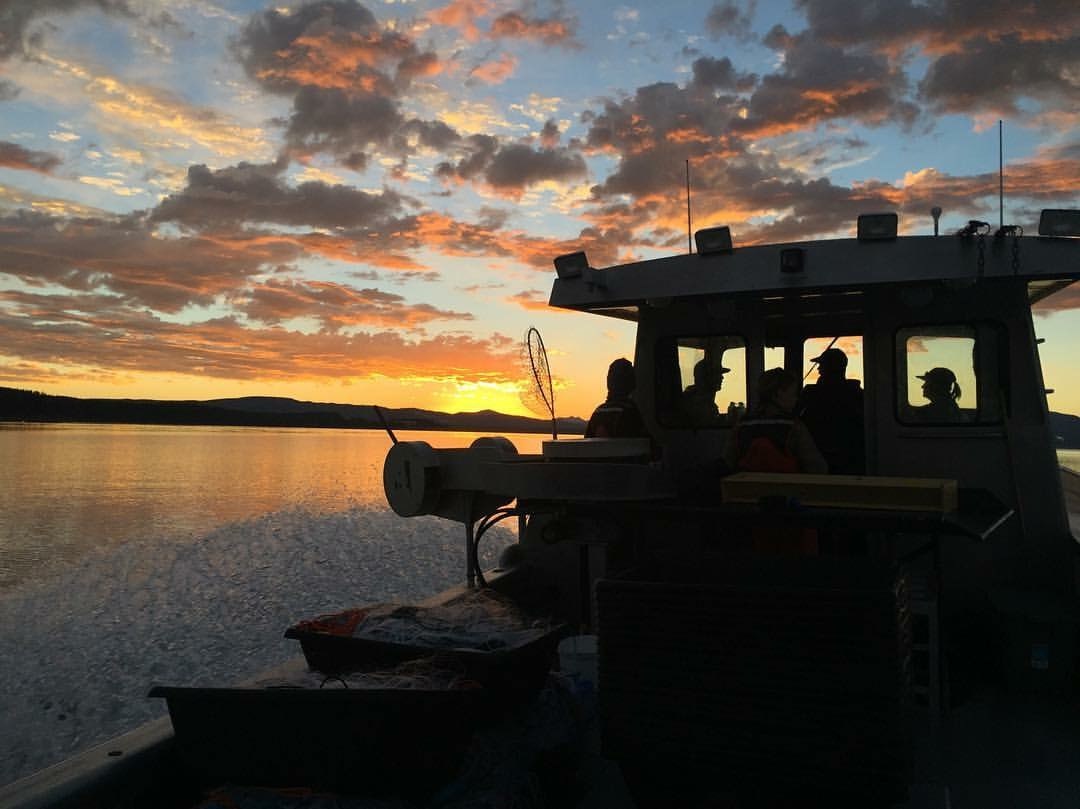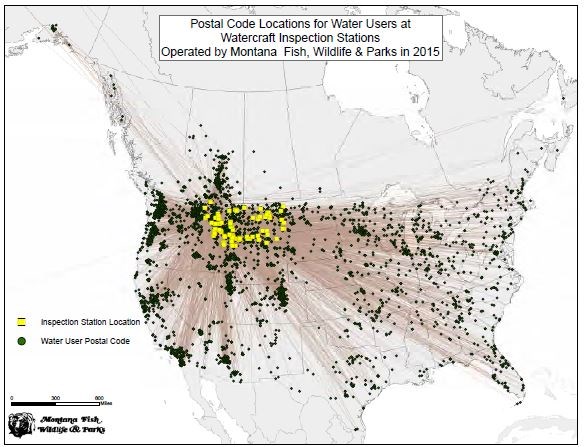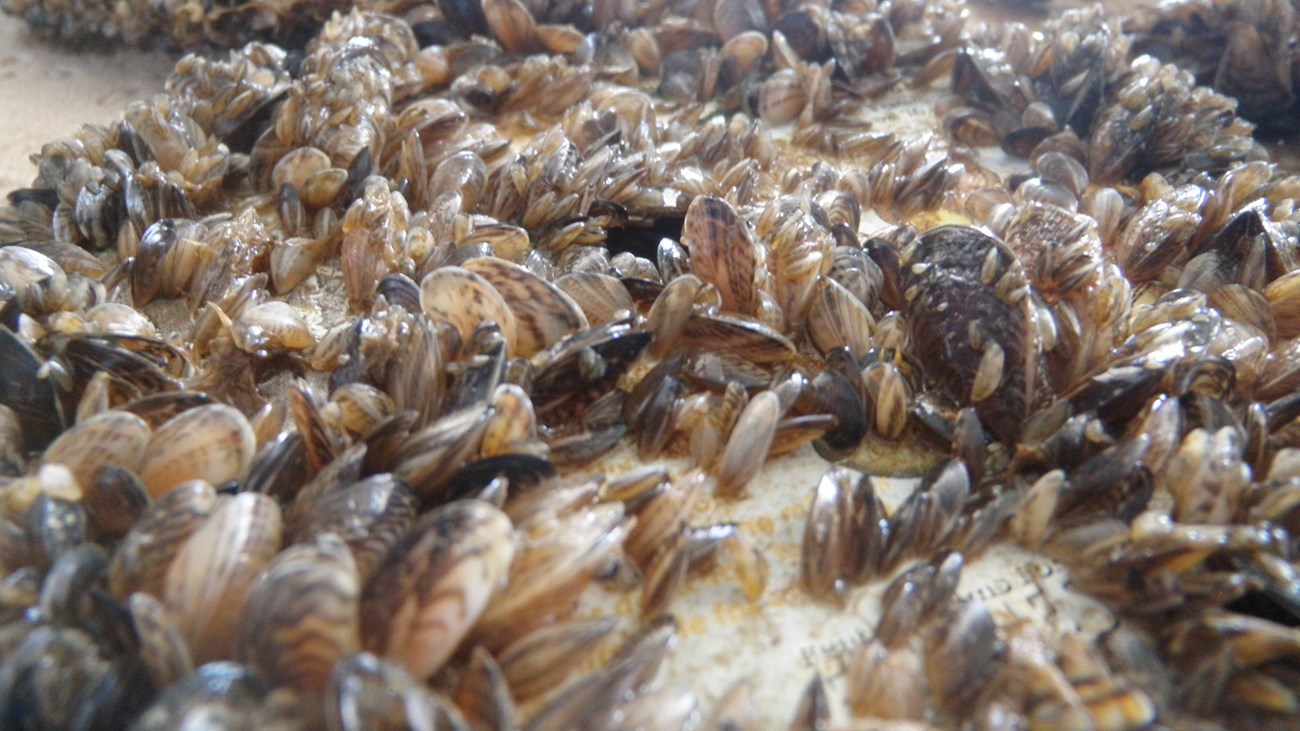"Perhaps no greater threat exists to public recreation, infrastructure, and aquatic resources in the Greater Yellowstone Ecosystem (GYE) than that from aquatic invasive species (AIS)." from Sestrich et al. 2017
Article
Protecting the Greater Yellowstone Ecosystem from Aquatic Invasive Species

AIS may be spread unintentionally to new waters by hitchhiking on any type of gear or equipment that comes in contact with AIS-contaminated water or sediment. Of greatest concern are the motorized and non-motorized watercraft transported to the Intermountain West annually from potentially infested waters all across North America (figure 1). Additionally, fishing gear and fire suppression equipment are some of the many vectors that inadvertently spread AIS. Aquatic invaders may also be introduced intentionally through illegal fish introductions and bait bucket releases known as “bucket biology,” and releases of household and classroom pets. Once AIS are established, there are few effective or inexpensive control measures—eradication is usually impossible. Therefore, preventing the spread of AIS is essential for conserving our aquatic resources, and the recreating public must assume an active role in these efforts.

Map provided by Montana Fish, Wildlife, and Parks
Greater Yellowstone Ecosystem at Risk
The GYE is a nationally important hydrologic resource with over 27,000 mi. (43,500 km) of streams and numerous lakes totaling over 278,000 surface ac (112,500 ha). World-famous headwater tributaries, including the Madison, Jefferson, Gallatin, Yellowstone, Bighorn, Wind, and Teton, give rise to the mighty Missouri, Snake, and Green rivers, which ultimately flow into the Gulf of Mexico, Pacific Ocean, and the Gulf of California, respectively. Because AIS can disburse downstream in flowing waters, the GYE is of national strategic importance in the fight against aquatic invaders. For example, AIS introduced into Yellowstone Lake could spread downstream into the Yellowstone River, its connected tributaries, and, ultimately, the Missouri River, threatening ecosystems, industry, and recreation along the way.The multitude of clear, cold, high elevation lakes and streams in the GYE support unique native aquatic species assemblages. Some endemic species, like the Yellowstone cutthroat trout, occur naturally nowhere else on earth. Historically, these native trout occupied about 61 lakes regionally, with Yellowstone Lake (96,000 surface ac [39,000 ha]) accounting for 78% of the overall area (Endicott et al. 2016). Within their historic range, 80% of all currently occupied streams (8,000 mi.; 13,000 km) occur within the GYE. Keeping AIS from invading these waters is essential for the long-term persistence of native species like cutthroat trout.
Tourism is the main source of economic support for many communities in the Yellowstone area (Marcus et al. 2012). Visitors travel from around the world to experience blue-ribbon trout fishing, diverse wildlife, and pristine waters and shorelines found in wilderness areas. About 40,000 visitors fish in Yellowstone National Park each year. In 2002, these anglers valued fishing in and near the park at $172-$977 a day, which translates into a total value of $67.5-$385 million (Kerkvliet et al. 2002). By physically altering habitat complexity, food webs, and reducing the amount and quality of food available, an AIS outbreak could have an immense impact on visitor use and enjoyment of waters and local economies.
High Priority AIS Species
Species considered by managers to pose the greatest risk to ecologic, recreational, and economic values in the GYE include zebra and quagga mussels, Asian clams, Asian carp species, Eurasian watermilfoil, hydrilla, flowering rush, whirling disease, and viral hemorrhagic septicemia. Zebra and quagga mussels, collectively called dreissenids, are of particular concern given their ability to attach to watercraft, survive many days out of water, and cause irreparable harm. Once established, these efficient filter feeders can significantly reduce the biomass of phytoplankton, the foundation of aquatic food webs (Nichols and Hopkins 1993, Caraco et al. 1997). Dreissenid mussels have the ability to rapidly colonize hard surfaces (U.S. Geological Survey 2016), thus blocking water supply pipes of power and water treatment plants, irrigation systems, and industrial facilities. In addition, mussels can impact recreation activities and associated economies by covering docks, boats, and beaches (figure 2). The Idaho Aquatic Nuisance Species Task Force (2009) estimated the potential economic impacts to infrastructure and recreation from a dreissenid introduction would be in excess of $94 million. Fortunately, dreissenid mussels are not yet present in the GYE due to proactive watercraft inspection and decontamination programs.
Photo © L. Elwell
Protecting the Greater Yellowstone Ecosystem’s Waters
Simply draining, cleaning, and drying all equipment that comes in contact with any waterbody provides a high degree of certainty AIS will not spread. As simple as these three steps seem, their broad cultural acceptance and strict adherence is yet to be realized. Responsibility for leading AIS prevention and management efforts falls to the states of Idaho, Montana, and Wyoming; numerous counties; Yellowstone and Grand Teton national parks; five national forests; three national wildlife refuges; and the Bureau of Land Management. Together, these entities with assistance from nonprofit organizations coordinate, prioritize, fund, and implement projects within the GYE through participation in the Greater Yellowstone Coordinating Committee AIS Cooperative (http://www.fedgycc.org/subcommittees/ aquatic-invasive-species-cooperative). Public outreach, watercraft inspections, and early detection survey and monitoring are the cornerstones of cooperators’ AIS programs.Watercraft Inspection Programs
Watercraft inspections are the most widely used tool for preventing the movement of AIS (Elwell 2015). Most western states as well as some national park units, local governmental entities, and others are operating stations where boat owners are required to stop for inspection. Although there are variations in program authorities and implementation, all watercraft inspection programs include a careful examination to determine if a watercraft and trailer are transporting suspected AIS.The two most common approaches to conducting inspections are at geographic borders (or roadside) and at waterbodies. Border (roadside) inspection stations are typically used to prevent AIS from entering a defined geographic area. These programs use a series of inspection stations placed at entries to an area, and all watercraft are required to stop for an inspection. In addition, these boat inspections provide an opportunity for public outreach about AIS.
Inspections at a waterbody typically address one of two management scenarios: containing existing AIS within a waterbody or preventing AIS from entering a waterbody. Within the western region, a concerted effort has been made to standardize watercraft inspection programs to allow for greater protection of aquatic resources, improve boater-inspection experience, and improve the management of watercraft inspection programs. For watercraft that do not pass inspection, established decontamination procedures are used that include lowering boat motors and pulling drain plugs (to remove all water), using a hot pressure washer to clean all surfaces, followed by a period that ensures the watercraft is allowed to dry.
GYE Inspection Program Results
Presently, there are 12 permanent watercraft inspection stations within the GYE (figure 3). With a few exceptions, these stations are located along roadways and operated seasonally. In addition, there are 37 inspection sites intermittently staffed with roving crews, typically located at high-use boat launch sites. During 2015, 19,821 inspections were conducted among all perma nent and roving check stations. Inspected watercraft originated from all 50 states, southern provinces of Canada, and even Mexico, Costa Rica, and France. Less than 1% of inspected watercraft had standing water or attached vegetation or organisms that required decontamination. The majority (69%) of watercraft in Wyoming that required decontamination had standing water in the motor that could potentially be harboring AIS (Wyoming Game and Fish Department 2015).
Protect Your Waters – Drain, Clean, Dry!
The potential ecological, social, and economic impacts from AIS invasions are devastating and irreversible. Thus, neither the public nor their agency servants can afford to sit back and consider defeat inevitable, especially in the GYE. Everyone needs to acknowledge the potential for water-based activities to spread AIS and accept responsibility for draining, cleaning, and drying waders, nets, motorboats, jet skis, canoes, kayaks, float tubes, and other equipment before moving to new waters. These simple actions will protect our aquatic ecosystems, water-based economies, and activities for ourselves and future generations.Literature Cited
Caraco, N.F., J.J. Cole, P.A. Raymond, D.L. Strayer, M.L. Pace, S.E.G. Findlay, and D.T. Fischer. 1997. Zebra mussel invasion in a large, turbid river: phytoplankton response to increased grazing. Ecology 78:588-602.Elwell, L., and R. Wiltshire. 2015. A management assessment of motorized watercraft and aquatic invasive species prevention in the Greater Yellowstone Area. Invasive Species Action Network, Livingston, Montana, USA.
Endicott, C., L. Nelson, S. Opitz, A. Peterson, J. Burckhardt, S. Yekel, D. Garren, T. Koel, and B. Shepard. 2016. Range-wide status of Yellowstone cutthroat trout (Oncorhynchus clarkii bouvieri): 2011.
Report prepared for the Yellowstone Cutthroat Trout Interagency Coordination Group, Bozeman, Montana, USA. Idaho Aquatic Nuisance Species Task Force. 2009.
Estimated potential economic impact of zebra and quagga mussel introduction into Idaho. Idaho Invasive Species Council, Boise, Idaho, USA. Idaho State Department of Agriculture. 2015.
Idaho aquatic invasive species program summary 2015. Boise, Idaho, USA.
Kerkvliet, J., C. Nowell, and S. Lowe. 2002. The economic value of the Greater Yellowstone’s blue-ribbon fishery. North American Journal of Fisheries Management 22:418-424.
Marcus, W.A., J.E. Meacham, and A.W. Rodman. 2012. Atlas of Yellowstone. University of California Press, Berkeley, California, USA. Montana Departments of Agriculture; Fish, Wildlife & Parks; Natural Resources and Conservation; and Transportation. 2014.
Montana aquatic invasive species program 2014 annual report. Helena, Montana, USA.
Nichols, K.H., and G.J. Hopkins. 1993. Recent changes in Lake Erie (north shore) phytoplankton: cumulative impacts of phosphorus loading reductions and the zebra mussel introduction. Journal of Great Lakes Research 19:637-647. U.S. Geological Survey. 2016.
Nonindigenous aquatic species database. Gainesville, Florida, USA. Wyoming Game and Fish Department. 2015. Wyoming aquatic invasive species 2015 program summary. Laramie, Wyoming, USA.
_______________________________________________________________________
Clint Sestrich is the Custer Gallatin National Forest Absaroka Beartooth Zone fisheries biologist. His passion and expertise lie in working collaboratively to conserve and restore native Yellowstone cutthroat trout populations, preventing the spread of aquatic invasive species, and providing public education focused on aquatic ecosystem function and management. Clint is currently the chair of the Greater Yellowstone Coordinating Committee AIS Cooperative. He has BS and MS degrees in Fish and Wildlife Management from Montana State University in Bozeman, Montana.
Part of a series of articles titled Yellowstone Science - Volume 25 Issue 1: Native Fish Conservation.
Last updated: August 1, 2017
